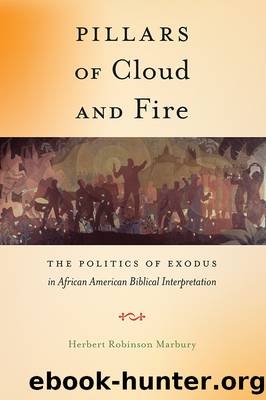Pillars of Cloud and Fire by Herbert Robinson Marbury

Author:Herbert Robinson Marbury [Marbury, Herbert Robinson]
Language: eng
Format: epub
ISBN: 9781479812509
Barnesnoble:
Publisher: New York University Press
Published: 2015-08-28T00:00:00+00:00
Moses, Man of the Mountain: Toward a Humanist Critique
Hurstonâs Moses, Man of the Mountain narrates a complex world shaped by religions and their attendant cultures. In exodus, Hurston explores questions about the limits of religion and religious imagination that perplexed the young Zora of Eatonville. She offers a strident critique to many in the Black Church and a people who have accepted the religion of their enslavers, a cautionary tale about the limits of any singular mosaic hero, and message of hope about the power of the collectiveâs religious imagination. Hurstonâs exodus contravenes mainstream exodus narratives of the Black Church but signifies her own pillar of fire stance.
From the beginning of the novel Hurston configures the forces of religion, law, and economy to match those in her own world; they contort bodies to conform to their regimes. The painful opening scene illustrates the connection:
âHave mercy! Lord, have mercy on my poor soul!â Women gave birth and whispered cries like this in caves and out-of-the-way places that humans didnât usually use for birthplaces. Moses hadnât come yet, and these were the years when Israel first made tears. Pharaoh had entered the bedrooms of Israel. The birthing beds of Hebrews were matters of state. The Hebrew womb had fallen under the heel of Pharaoh.33
The speaker, a Hebrew woman in labor, directs her cry for mercy to the âLord,â which usually refers to the Hebrew deity, Yahweh. Hurston takes the ambiguity of the womanâs language to expose a similar ambiguity in the connection between a religion and the political, social, and cultural interests it serves. Although the women in Hurstonâs novel cry out to the Lord, in the book of Exodus, the name of the God of the Israelites has not even been revealed to Moses, let alone the Hebrews.34 If she is calling to the only deity present, Pharaoh, then her cry has no hope of eliciting a favorable response. The imperial system does not show mercy to the conquered. However, if she intends to summon another divine presence, one both powerful enough to relieve her agony and sympathetic enough to will her release, then Hurston introduces transcendence. It is key to an oppressed peopleâs religious imagination. The womanâs hope arises from her ability to envision a reality that is not present. But as Hurston directs the plot, the womanâs petition goes unanswered. Rather, the presence of an Egyptian deity, Pharaoh, fills the birthing chamber not with mercy, but with crushing imperial power. Both the agony in the womanâs cry and the imperial response recall similar unanswered petitions from innumerable women in slave quarters throughout the South as they brought life into the world. Despite the unanswered petition, the power of humans to imagine life as other than it is continues to drive Hurstonâs plot.
In a parallel scene between Amram and Caleb, two Hebrew men, and an unnamed Egyptian foreman, Hurston shows how cultural interests and religious interests are coterminous. Amram appears fitted with the conscience of the New Negro, but articulated through southern speech and rural wisdom.
Download
This site does not store any files on its server. We only index and link to content provided by other sites. Please contact the content providers to delete copyright contents if any and email us, we'll remove relevant links or contents immediately.
| Buddhism | Christianity |
| Ethnic & Tribal | General |
| Hinduism | Islam |
| Judaism | New Age, Mythology & Occult |
| Religion, Politics & State |
Cecilia; Or, Memoirs of an Heiress — Volume 1 by Fanny Burney(31341)
Cecilia; Or, Memoirs of an Heiress — Volume 3 by Fanny Burney(30938)
Cecilia; Or, Memoirs of an Heiress — Volume 2 by Fanny Burney(30894)
The Secret History by Donna Tartt(16643)
Sapiens: A Brief History of Humankind by Yuval Noah Harari(13067)
Leonardo da Vinci by Walter Isaacson(11912)
The Radium Girls by Kate Moore(10914)
Sapiens by Yuval Noah Harari(4546)
The Wind in My Hair by Masih Alinejad(4427)
How Democracies Die by Steven Levitsky & Daniel Ziblatt(4407)
Homo Deus: A Brief History of Tomorrow by Yuval Noah Harari(4287)
Endurance: Shackleton's Incredible Voyage by Alfred Lansing(3851)
The Silk Roads by Peter Frankopan(3769)
Man's Search for Meaning by Viktor Frankl(3644)
Millionaire: The Philanderer, Gambler, and Duelist Who Invented Modern Finance by Janet Gleeson(3573)
The Rape of Nanking by Iris Chang(3522)
Hitler in Los Angeles by Steven J. Ross(3443)
The Motorcycle Diaries by Ernesto Che Guevara(3340)
Joan of Arc by Mary Gordon(3262)
